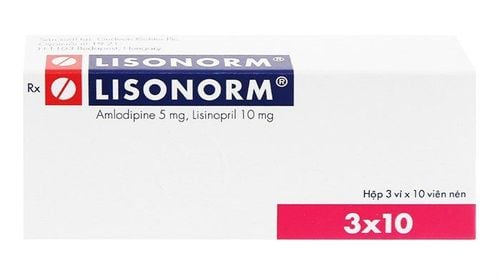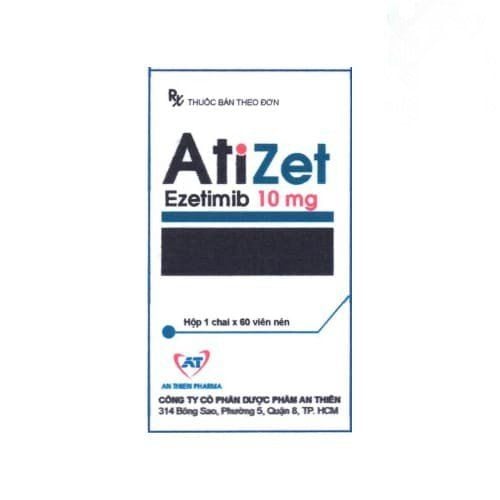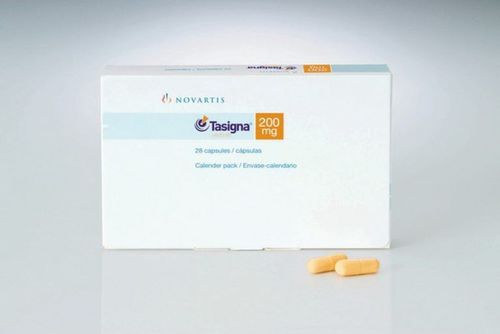This is an automatically translated article.
Trinitrina belongs to the group of cardiovascular drugs with the main ingredient nitroglycerin, which is an antianginal drug belonging to nitrate derivatives that relaxes vascular smooth muscle, reducing preload and afterload, leading to decreased myocardial oxygen use and decreased cardiac function.1. What is Trinitrina?
Trinitrina drug has the main ingredient is nitroglycerin, an organic nitrate that, when entering the body, is converted into nitric oxide by glutathione-S-reductase and cysteine. Then NO combines with the thiol group to form nitrosothiol (R-SNO), which activates guanylate cyclase to convert guanosine triphosphate (GTP) to guanosine 3'5' cyclic monophosphate (GMPc). GMPc makes myosin in the vascular muscle fibers inactivated, unable to combine with actin, resulting in vasodilation. The drug Trinitrina mainly acts on the venous system to dilate the arteries and arterioles. In particular, varicose veins will cause blood to stagnate in the periphery and in the viscera, reducing the amount of blood returning to the heart (reducing preload), as a result, reducing the pressure in the heart chambers. In addition, slight dilation of the arterioles leads to a decrease in peripheral resistance and left ventricular pressure during systole, resulting in a decrease in myocardial oxygen demand (reduced afterload). The nitrates also inhibit platelet aggregation.In addition, nitroglycerin also causes direct and transient systemic vasodilation, reducing cardiac output, coronary vasodilation, temporarily increasing coronary flow, reducing peripheral resistance and systolic flow, thus lowering blood pressure. pressure. Nitroglycerin also redistributes blood vessels to the heart, increasing auxiliary circulation to the ischemic heart area in favor of the subendocardium.
2. Indications and contraindications Trinitrina
2.1. Indications Trinitrina is usually indicated in the following cases:
Acute myocardial infarction Paroxysmal hypertension during surgery (especially cardiovascular surgery) using the infusion form Heart failure Acute cardiac pulmonary edema Angina serious 2.2. Contraindications Some contraindications of Trinitrina include:
Low blood pressure, cardiovascular collapse Severe anemia Increased intracranial pressure due to trauma, cerebral hemorrhage Right ventricular myocardial infarction Aortic stenosis, disease constrictive hypertrophic myocarditis Constrictive pericarditis Allergic to organic nitrates Closed-angle glaucoma Patients taking concomitant phosphodiesterase-5 (PDE-5) inhibitors such as sildenafil, tadalafil, vardenafil
3. Dosage of Trinitrina
Depending on the patient and the goal of treatment, the dose of Trinitrina used will be different, specifically as follows:
Treatment of acute myocardial infarction: nitroglycerin is the initial basic treatment in patients with infarction. acute myocardial. Patients with acute myocardial infarction with prolonged angina, hypertension or acute pulmonary edema should receive intravenous nitroglycerin infusion in the first 24-48 hours from 12.5-25 micrograms/minute, maintaining 10-20 micrograms. /min (do not have systolic blood pressure < 90 mmHg and heart rate > 110 beats/min
Patients with left ventricular failure or severe hypertension: use low initial dose to avoid excessive reduction in blood pressure, 5 micrograms /min was increased from 5-20 micrograms/minute every 5-10 minutes, up to a maximum of 200 micrograms/minute until mean blood pressure decreased by 10% in normotensive subjects and about 30% in hypertensive subjects. blood pressure; injection maintained for 24 hours or longer.Efficacy is usually maintained for 12 hours after stopping infusion
Treatment of hypertension: intravenous infusion at a dose of 5-100 micrograms/minute, when response is reduced dose and increase infusion interval.The antihypertensive effect appears within 2-5 minutes and persists for about 3-5 minutes after stopping the infusion.Note that only 25% reduction is allowed within the first hour. Tri . overdose case nitrina symptoms occur mainly due to enhanced vasodilation and methemoglobinemia. The usual manifestations of overdose are hypotension, tachycardia, cold pale skin, headache, dizziness, confusion, visual disturbances, nausea and vomiting with abdominal pain, palpitations, syncope, failure heart-circulation. In this case, the following should be managed:
Reduce the infusion rate immediately Place the patient in the Trendelenburg position (stretch with passive climbing movement) Intravenous fluids Use alpha-adrenergic agonists if needed Treatment of cyanosis due to methemoglobinemia: proposed intravenous treatment with 1% methylene blue (1-2 mg/kg). A dose of 50 mg/kg should be given orally in less severe cases
4. Side effects of Trinitrina
In some patients when using Trinitrina, the following side effects may occur:
Acute and persistent headache due to cerebral vasodilation Dizziness, confusion, weakness Increased heart rate, low blood pressure Sadness vomiting, vomiting, sweating, pallor and fainting Skin redness, exfoliative dermatitis Postural hypotension Burning sensation and rash
5. Be careful when using Trinitrina
Some general notes when using Trinitrina:
Be very careful when using Trinitrina for patients with traumatic brain injury and brain hemorrhage Only use Trinitrina intravenous infusion in the hospital, monitor blood pressure , heart rate and clinical status of the patient. In critically ill patients, monitoring of central venous pressure (CVP) and/or pulmonary artery pressure, cardiac output, and electrocardiogram (ECG) is required. Because in 1.5 ml of Trinitrina concentrate contains 0, 82 ml of ethanol may be hazardous to patients with alcoholism. Trinitrina should be used with caution in pregnant or lactating women, children and high-risk patients such as patients with liver disease or epileptic seizures Trinitrina concentrate should not be used for infusion solutions during pregnancy, especially during the first 3 months of pregnancy unless clearly needed. It is not known with certainty whether nitroglycerine is excreted in human milk. no, so special care should be taken when prescribing nitroglycerine to lactating women. Common drug interactions of Trinitrina include:
Vasodilators, antihypertensives and diuretics may potentiate the effect. hypotensive effect of nitroglycerine The peripheral vasodilating effect of nitroglycerine is hindered if co-administered with indomethacin. Inhibition of prostaglandins Intravenous administration of nitroglycerine reduces the thrombolytic effect of alteplase and the anticoagulant effects of heparin Sildenafil enhances the hypotensive effect of nitrates, synergistic with organic nitrates. point. Trinitrina belongs to the group of cardiovascular drugs with the main ingredient nitroglycerin, which is an antianginal drug belonging to nitrate derivatives that relaxes vascular smooth muscle, reducing preload and afterload, leading to decreased myocardial oxygen use and decreased cardiac function.
To ensure effective treatment and avoid unwanted side effects, patients need to strictly follow the instructions of the doctor, professional pharmacist.
Follow Vinmec International General Hospital website to get more health, nutrition and beauty information to protect the health of yourself and your loved ones in your family.
Please dial HOTLINE for more information or register for an appointment HERE. Download MyVinmec app to make appointments faster and to manage your bookings easily.













